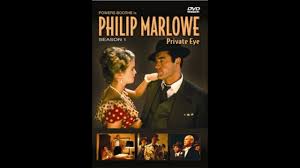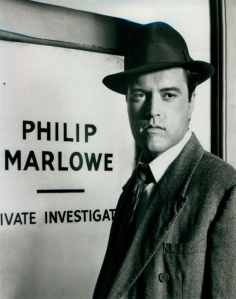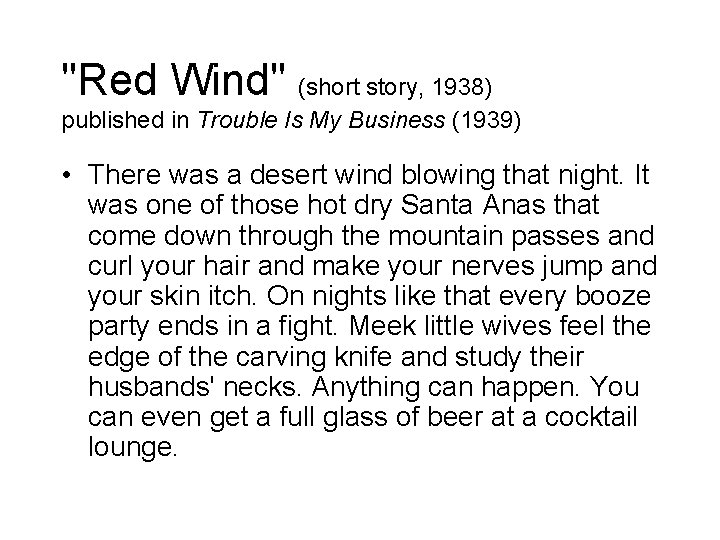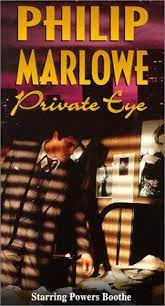IMDb meta-data is 11 episodes of 48 minutes each. Ratings are below.
Genre: Hard Boiled.
Verdict: An intoxicating cocktail of cynicism and optimism.

These titles from the second season came my way:
Blackmailers Don’t Shoot rated 7.4 by 53 cinematizens,
Spanish Blood rated 7.2 by 32 cinematizens,
Pick-up on Noon Street rated 7.4 by 34 cinematizens,
Guns at Cyrano’s rated 7.2 by 30 cinematizens,
Trouble is My Business rated 7.5 by 35 cinematizens, and
The Red Wind rated 7.5 by 30 cinematizens.
From the typewriter of Raymond Chandler this series adapts some of his early short stories for the screen. A few of these early stories featured Mallory before the gestation of Philip Marlowe in print, but Marlowe has been retrofitted into these scripts. (Word to the wise: the entry on Wikipedia is not useful for the early days of Marlowe.) These are episodes from the second season. My efforts to locate the first series have not (yet) been successful.

In these outings Marlowe is (retrospectively) the Marlowe of The Big Sleep, tough and cynical, incarnated by Powers Booth (1948-2017), the only Marlowe I have seen who has the bulk, with added jowls and a vocal rasp from all those cigarettes and scotch. Some cluey aficionados rank him as the #2 Marlowe after Bogart. Could be. That’s one toss I won’t argue.
Taken together in these episodes what I noticed is the racial themes in Spanish Blood and Pick-up on Noon Street, and I wondered how closely that aligned with Chandler’s original stories, or was it the production company, HBO, beating the virtue drum? I don’t recall anything about either Latinos or Blacks from Chandler’s stories, except in the background as gardeners or drivers, maids and servants. Make of that what one will. I may have to re-read these stories myself for a refresher.
There is also a recurrent motif in that the victims of a crime had contrived the crime to gain publicity in the dream factory town, where publicity is oxygen, where if you are not going up then you are going down on the popularity gauge, because someone else is going up on it. That seemed surprisingly current given the great desire of so many people to be victims.

My personal favourite from this half-dozen is The Red Wind. Its evocation of the Santa Ana wind is a malevolent character in the wings, just off camera, in this drama. It precipitates actions, explains method, and drives the momentum. If anything this is even more effective on film than on the page. Maury Chaykin, before he went straight and became Nero Wolfe, is as repellant as a Republican Senator, lazy, stupid, corrupt, and greedy. He positively drips malice off the screen onto the carpet in front of the television. Yuk! (Note he is not in the story but an addition for the screen play and wonderful.) While the screenplay retains all the convolutions, for unknown reasons it changed the context to a political campaign, as was the case also in Spanish Blood. It also changed the colour of the bolero jacket that is crucial to the plot. Change for the sake of change is not limited to management.
The staging is for television, slow and methodical and that allows for Marlowe’s worldweary voiceovers. I went shopping for Season One but cannot find it in any of the usual locations. Odd that.
It is also striking that a man-eating femme fatale is the pivot in all of these stories. Did Chandler fear women that much. It sure seems it watching these in a row. Moreover, the women, though played by different actors, bear a resemblance to each other, but I put that down to the preferences of the casting director for the willowy athlete. The only one miscast is the lead in Red Wind: The camera looks right through her. (Every time I encounter this story I react to Marlowe’s closing speech on the pier. It seems ill judged to me. Maybe the flyer could only afford the pearls he bought and dreamed of replacing them sometime with the real thing. But Marlowe has no truck with dreamers.)
It offers plenty of eye candy with period dress, automobiles, and much location shooting of the vanishing 1930s Hollywood and, more generally, Los Angeles. Love those California Spanish mansions, and the tropical foliage (in which lurk deranged rapists, murderers, black-widow spider women, and drug-addled teenagers). The cigarette smoking is constant by one and all, as it was then. Most of all there is the light, the sun, the blue sky above all the depravity. Sunshine Noir as this style came to be called is aborning in these stories, and some of the quips are gold, if ephemeral, perhaps that is fool’s gold that flashes in the sunlight.
The user reviews on IMDb are replete with pedants picking errors in the models of cars, street addresses, and other, like essentials. Keeps the trolls busy, anyway.

